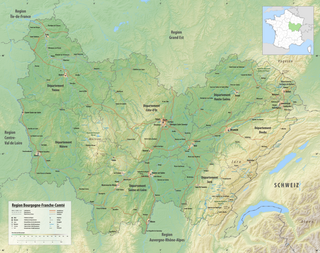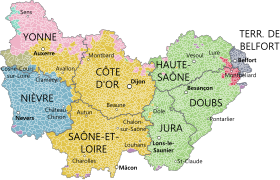Bourgogne-Franche-Comté
| Bourgogne-Franche-Comté | |
|---|---|

|

|
| Basic data | |
| Country |
|
| prefecture | Dijon |
| President of the Regional Council | Marie-Guite Dufay ( PS ) |
| population | 2,811,423 (2017) |
| Population density | 58.8 inhabitants per km² |
| surface | 47,790 km² |
| Departments | 8th |
| Arrondissements | 24 |
| Community associations | 120 |
| Cantons | 152 |
| Communities | 3,702 |
| ISO-3166-2 code | FR-BFC |
 Relief map of the Bourgogne-Franche-Comté region |
|
Bourgogne-Franche-Comté [ buʁgɔɲ fʁãʃ kɔ̃te ] (abbreviation BFC ; German Burgundy- Free County [Burgundy] ) is the name of the French region that was created on January 1, 2016 through the merger of the previous regions of Burgundy and Franche-Comté . The capital of the region is Dijon .
Bourgogne-Franche-Comté is the fifth largest region with 47,784 km² (excluding overseas regions) and has 2,811,423 inhabitants (as of 2017), making it the third smallest region in terms of population. It is divided into the eight departments of Côte-d'Or , Doubs , Haute-Saône , Jura , Nièvre , Saône-et-Loire , Territoire de Belfort and Yonne . It borders (starting clockwise from the north) with the Grand Est region , Switzerland and the Auvergne-Rhône-Alpes , Center-Val de Loire and Île-de-France regions .
Cities
The most populous cities in the Bourgogne-Franche-Comté region are:
| city | Inhabitants (year) | Department |
|---|---|---|
| Dijon | 156,920 (2017) | Côte-d'Or |
| Besançon | 115,934 (2017) | Doubs |
| Belfort | 47,656 (2017) | Territoire de Belfort |
| Chalon-sur-Saône | 45,096 (2017) | Saône-et-Loire |
| Auxerre | 34,634 (2017) | Yonne |
| Nevers | 32,990 (2017) | Nièvre |
| Mâcon | 33,638 (2017) | Saône-et-Loire |
| Montbeliard | 25,395 (2017) | Doubs |
| Sens | 25,935 (2017) | Yonne |
| Dole | 23,708 (2017) | law |
politics
Political structure
The Bourgogne-Franche-Comté region is divided into eight departments :
| OZ | = Ordinal number of the department | Arr. | = Number of arrondissements | According to | = Number of municipalities |
| W. | = Coat of arms of the department | Kant. | = Number of cantons | ||
| ISO | = ISO-3166-2 code | GV | = Number of municipal associations |
| OZ | W. | Department | prefecture | ISO | Arr. | GV | Kant. | According to | Residents January 1, 2017 |
Area (km²) |
Density (inh / km²) |
|---|---|---|---|---|---|---|---|---|---|---|---|
| 21st |
|
Côte-d'Or | Dijon | FR-21 | 3 | 19th | 23 | 698 | 533.819 | 8,763 | 61 |
| 25th |
|
Doubs | Besançon | FR-25 | 3 | 18th | 19th | 573 | 539.067 | 5,234 | 103 |
| 39 |
|
law | Lons-le-Saunier | FR-39 | 3 | 17th | 17th | 494 | 260.188 | 4,999 | 52 |
| 58 |
|
Nièvre | Nevers | FR-58 | 4th | 13 | 17th | 309 | 207.182 | 6,817 | 30th |
| 70 |
|
Haute-Saône | Vesoul | FR-70 | 2 | 19th | 17th | 539 | 236,659 | 5,360 | 44 |
| 71 |
|
Saône-et-Loire | Mâcon | FR-71 | 5 | 20th | 29 | 565 | 553,595 | 8,574 | 65 |
| 89 |
|
Yonne | Auxerre | FR-89 | 3 | 16 | 21st | 423 | 338.291 | 7,433 | 46 |
| 90 |
|
Territoire de Belfort | Belfort | FR-90 | 1 | 3 | 9 | 101 | 142,622 | 610 | 234 |
| total | 24 | 120 | 152 | 3,702 | 2,811,423 | 47,790 | 59 | ||||
Regional council
Result of the election of the regional council on December 13, 2015:
- List Marie-Guite Dufay (Union of the Left from PS , PRG , EELV and FG ): 34.68% = 402,948 votes, 51 seats
- List François Sauvadet (Union de la Droite from LR , UDI and MoDem ): 32.89% = 382,188 votes, 25 seats
- Sophie Montel list ( FN ): 32.44% = 376,911 votes, 24 seats
economy
Bourgogne is particularly known for its viticulture. Over 200 million bottles are filled annually in the AOC wine cellars ( Appellation d'Origine Contrôlée ) south of Dijon. The vineyards and picturesque villages of the Plateau bourguignon ( Côte de Beaune , Côte challonaise , Côte de Nuits ) even attract tourists from Japan and the United States of America.
Cattle breeding and the meat industry are very present further west : the white Charolais cattle graze here; the meat tested by the surrounding laboratories is world-class. In general, the Bourgogne with its oak and pine forests is a kind of green lung for France and, as the source of the Yonne, it supplies water for the Paris basin ( Bassin parisien ). The factories of the steel industry in Le Creusot , for example, had to close their doors in the past few decades; Of its importance as an industrial region, almost all that remains is the good TGV connection, which connects the région-passoire (transit region), which is considered part of the diagonale du vide (the empty diagonal of France), with Paris, Lyon and Marseille.
The Franche-Comté region is known as “Siberia of France” (sometimes −20 to −40 degrees in winter) and is characterized by poor infrastructure in the village-like Jura basin. Only cheese production thrives here (AOC cheese: Comté & Morbier).
Only in the south and in the north (Jura / Oyonnaux and Montbéliard / Belfort / Sochaux ) are large world-class companies located: the French car manufacturer Peugeot produces near Montbéliard and Sochaux ; In Belfort, the railway and TGV supplier Alstom is boosting the economy and in the southern Jura, not far from Oyonnaux, there is the plastics-vallée - the location of the largest plastic processing companies in Europe, the French equivalent of Silicon Valley . The two economic centers benefit from the Rhine-Rhône connection, the proximity to Lyon , Alsace and Switzerland ( Basel ). Other economic centers are the regional capitals Dijon and Besançon.
However, in terms of population development, this is just as much a shortcoming as the weak infrastructure, because all the surrounding regions and cities of France are overtaking the tranquil Franche-Comté with the small Besançon.
history
The region, newly created in 2016, unites the historic Burgundian heartland, which was already divided into two political units in the Middle Ages: the Duchy of Burgundy , which made up a large part of the later region of Bourgogne , and the Free County of Burgundy (French Franche Comté de Bourgogne ), which largely coincides with the later Franche-Comté region coincided.
The name was initially formed provisionally from the alphabetical order of the merged regions and was finally confirmed by the Conseil d'État on October 1, 2016, following a resolution by the regional council .
The Nièvre department is roughly the same size as the historical Nivernais . The Territoire de Belfort belonged to the German annexation of Alsace-Lorraine after the Franco-German War (1870-71) to Alsace after and was the First World War not with the Haut-Rhin department reunited, but to a dedicated department that is no longer the Alsace is counted. The northern part of the Dèpartemants Yonne was historically part of the Champagne .

Web links
Individual evidence
- ↑ Résultats régionales 2015 - Bourgogne, Franche-Comté on linternaute.com, accessed on January 6, 2016.
- ↑ La carte des régions en 2015 on vie-publique.fr, accessed on May 9, 2015.
- ↑ Mathilde SIRAUD: Occitanie, Nouvelle-Aquitaine ...: discordes autour des nouveaux noms de régions In: LeFigaro.fr , June 27, 2016th




